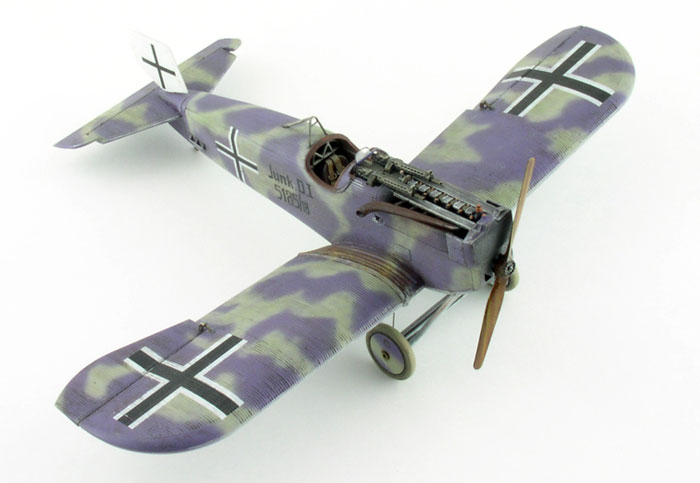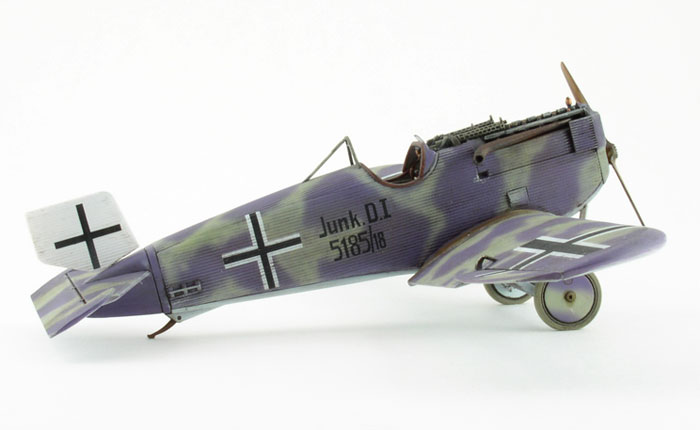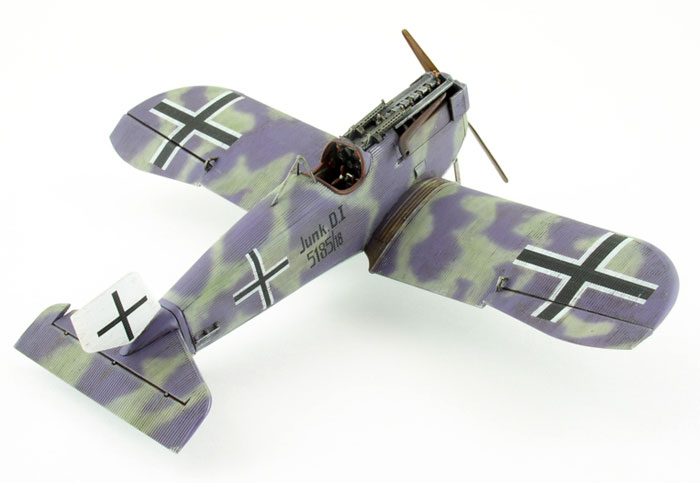Roden's 1/48 scale
Junkers D.I
by Martin Sokolowski

|
Junkers D.I
s/n 5185/18, Western Front, Autumn 1918 |

Roden's 1/48 scale Junkers D.I is available online from Squadron.com
The increasing development of the aviation during the WWI was aimed at improving speed, range and maneuverability. Airplanes from that period were still produced from the traditional materials such as wood, canvas and the structural strength was obtained by using struts and bracing wires.
However, there were a few airplanes which were significantly diverse from the previously made aircrafts. For instance, Junkers J.I, Junkers CL.I and Junkers D.I were made entirely of metal.
The framework was made of duraluminum tubes and was covered with sheets of corrugated aluminum
patented in 1912 by German designer Hugo Junkers.
The Junkers J.I was nicknamed the Blechesel ("Sheet Metal Donkey"), a ground attack plane, and made its first flight in the winter of 1916.

After that, Junkers began work on support plane for the army, the CL.I and D.I as a fighter plane.
The first flight of the J.7, prototype of the future fighter, was in September 1917.
The new design was confronted by a many problems, like vibration of wings in flight, bad controllability of ailerons and many more.
Nevertheless, the biggest problem was the absence of a suitable engine.
The best engine available at the time was the Mercedes D.IIIa, which developed only 160 hp.,
enough for a traditional airplane, but not for the much heavier metal design.
After many modifications to the overall design like new shape of the fuselage, increased wing span, and new shape of the ailerons, in July 1918 Junkers entered into the Second Fighter Competition with new J.7 and J.9 (D.I).
The pilots that took part in test flights recommended it strictly as "an airplane for fighting with balloons and airships".
Furthermore, as a low-wing monoplane, Junkers had a limited view downwards from the cockpit, and this also has resulted in disapproval from the many pilots.
The Idflieg (Inspektion der Fliegertruppen - "Inspectorate of Flying Troops") ordered a series of 40 aircraft, but by the end of the war the Junkers had built only 15 machines. At the same time, affiliated company Junkers-Fokker constructed 13 machines of the D.I type and 12 more were produced by the time the Allies ordered the cessation of all aircraft production in Germany in 1919.

In October 1918 these machines were sent to the front, but the war approached its end and the Junkers D.I didn’t take much part in the fighting.
Junkers all-metal aircraft had big advantages over wood and linen types.
For instance, metal aircraft were not subject to the whims of the weather, while the canvas and wood of other machines deteriorated very quickly.
After the war, Junkers aircraft had an opportunity once again to prove their advantages.
In 1919 German air forces assisted the governments of the Baltic countries in their struggle against Russia.
During WWII without any doubt only two events were truly radical advances in aircraft technology which were the invention of the gun synchronizer and the creation of all-metal aircraft designs.
Construction and Painting |
This model (Roden 1/48) represents Junkers D.I s/n 5185/18, Western Front, Autumn 1918.
My model was built with the addition of the PE seat belts and homemade dials. The propeller was sanded to the proper thickness and foot plates (walkways) were added to the wings. The control stick was deflected to match the control surfaces.
To paint the model, I used home mix of Tamiya acrylics to obtain colors close to mauve and pale mossy green for top and very light bluish white for the bottom of the fuselage.
As a color reference I used charts from MisterKitUSA website (www.misterkitusa.com).
Finally, the decals that Roden provided with the kit required plenty of SOLVASET setting solution to settle down. (Micro Sol/Set was not strong enough)
References:
Windsock Datafile 33 – Junkers D.I by Peter M. Grosz
Profile Publications 187 – The Junkers Monoplanes
MisterKit USA website - www.misterkitusa.com
The Aerodrome - www.theaerodrome.com
Model, Images and
Text Copyright © 2008 by Martin Sokolowski
Page Created 15 June, 2008
Last Updated
15 June, 2008
Back to HyperScale
Main Page |
Home
| What's New |
Features |
Gallery |
Reviews |
Reference |
Forum |
Search